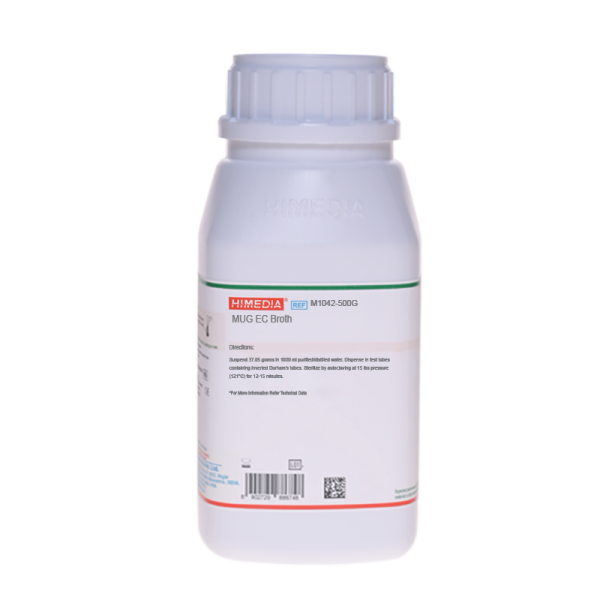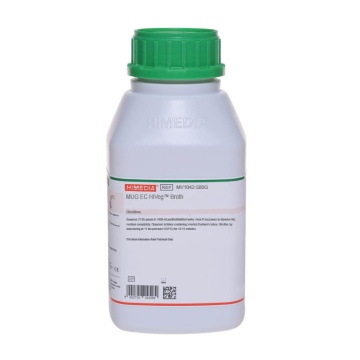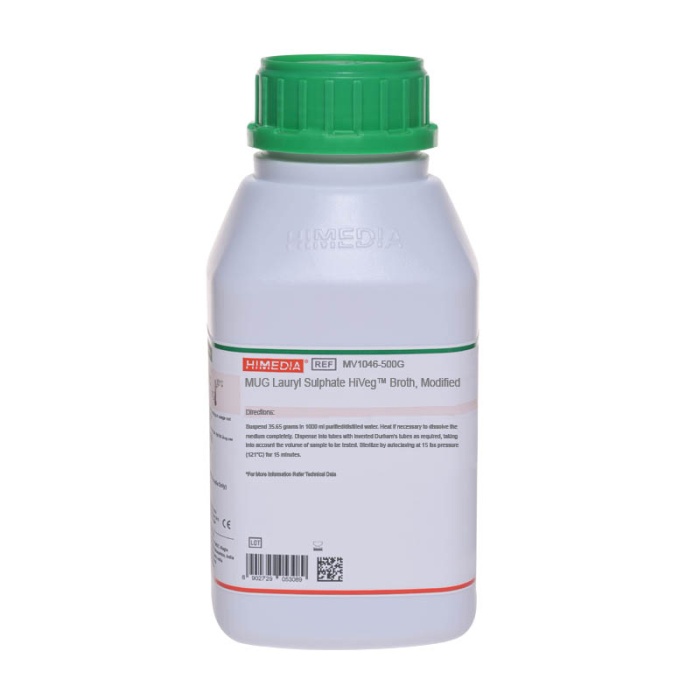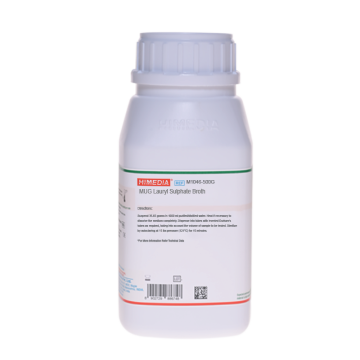 Your enquiry has been submitted
Your enquiry has been submitted
MUG EC Broth
Intended Use
Recommended for detection of Escherichia coli in water and food samples by a fluorogenic method.
Composition**
| Ingredients | Gms / Litre |
|---|---|
| Tryptone | 20.000 |
| Lactose | 5.000 |
| Bile salts mixture | 1.500 |
| Dipotassium hydrogen phosphate | 4.000 |
| Potassium dihydrogen phosphate | 1.500 |
| Sodium chloride | 5.000 |
| 4-Methylumbelliferyl β-D-Glucuronide (MUG) | 0.050 |
Final pH (at 25°C): 6.9±0.2
**Formula adjusted, standardized to suit performance parameters
Directions
Suspend 37.05 grams in 1000 ml purified/distilled water. Heat, if necessary to dissolve the medium completely. Dispense in tubes containing inverted Durham's tubes. Sterilize by autoclaving at 15 lbs pressure (121°C) for 12-15 minutes.
Principle And Interpretation
Escherichia coli is a member of faecal coliform group of bacteria. It is a member of the indigenous faecal flora of warm-blooded animals. E.coli is considered a specific indicator of faecal contamination and the possible presence of enteric pathogens. EC Broth was devised by Hajna and Perry (4) and further modified by addition of the fluorogenic compound MUG. MUG EC Broth is also recommended by APHA for the analysis of drinking water, surface and ground water and waste-water for the presence of E.coli (2). MUG permits rapid detection of E. coli when medium is observed for fluorescence using UV Light (1,8). MUG also detects anaerogenic strains which may not be detected in conventional procedure (8). MUG is hydrolyzed by the enzyme β-glucuronidase possessed by E.coli to yield a fluorescent end product 4-Methylumbelliferone. Tryptone provides essential nutrients. Lactose is the fermentable carbohydrate. Sodium chloride maintains osmotic equilibrium. The medium has a strong buffering system to control the pH in the presence of fermentative action. The bile salts inhibit gram-positive bacteria especially Bacillus species and faecal Streptococci. Mostly beta-glucuronidase activity occurs within 4 hours but some weak beta- glucuronidase-positive strains require overnight incubation (2). The fermentation of lactose by lactose fermentors leads to acidification of the medium, resulting in drop of pH. Adjustment of pH of cultures by sodium hydroxide enhanced fluorescence as observed by Maddocks and Greenman (7).Similarly Freir and Hartman (3) noticed that exposure of tubes to ammonia fumes enhanced fluorescence. Large number of Proteus vulgaris if present, may suppress gas production of E.coli, however fluorescence permits detection of E.coli in pure or mixed cultures within 4 to 24 hours.
Type of specimen
Food samples; Water samples
Specimen Collection and Handling:
Inoculate the test water sample into PA Broth (M1186) and Lauryl Sulphate Broth (M080). After an incubation at 35-37°C for 18-24 hours, all presumptive tubes showing growth, gas or acidity is further tested using MUG EC Broth (M1042). After an incubation at 35-37°C for 4-24 hours, the presence of a bright blue fluorescence is considered as a positive response for E. coli. After use, contaminated materials must be sterilized by autoclaving before discarding.
Warning and Precautions :
Read the label before opening the container. Wear protective gloves/protective clothing/eye protection/face protection. Follow good microbiological lab practices while handling specimens and culture. Standard precautions as per established guidelines should be followed while handling specimens. Safety guidelines may be referred in individual safety data sheets.
Limitations :
- Well isolated colonies must be used to avoid erroreous results.
- Fluorescence can be improved by addition of 2-3 drops of NaOH.
Performance and Evaluation
Performance of the medium is expected when used as per the direction on the label within the expiry period when stored at recommended temperature.
Quality Control
Appearance Cream to yellow homogeneous free flowing powder
Colour and Clarity of prepared medium Yellow coloured clear solution without any precipitate
Reaction Reaction of 3.7% w/v aqueous solution at 25°C. pH : 6.9±0.2
pH 6.70-7.10
Cultural Response
Cultural characteristics observed after an incubation at 35 - 37°C for 4 - 24 hours.
| Organism | Inoculum (CFU) | Growth | Fluorescence (under uv) (at 366 nm) |
|---|---|---|---|
| Escherichia coli ATCC 25922 (00013*) | 50-100 | luxuriant | positive, throughout the tube |
| #Klebsiella aerogenes ATCC 13048 (00175*) | 50-100 | luxuriant | Negative |
| Staphylococcus aureus subsp. aureus ATCC 25923 (00034*) | >=104 | inhibited | |
| Salmonella Typhi ATCC 6539 | 50-100 | good | Negative |
| Shigella flexneri ATCC 12022 (00126*) | 50-100 | good | Negative |
Key: *Corresponding WDCM numbers. # Formerly known as Enterobacter aerogenes
Storage and Shelf Life
Store between 10-30°C in a tightly closed container and the prepared medium at 2-8°C. Use before expiry date on the label. On opening, product should be properly stored dry, after tightly capping the bottle in order to prevent lump formation due to the hygroscopic nature of the product. Improper storage of the product may lead to lump formation. Store in dry ventilated area protected from extremes of temperature and sources of ignition. Seal the container tightly after use. Product performance is best if used within stated expiry period.
Disposal
User must ensure safe disposal by autoclaving and/or incineration of used or unusable preparations of this product. Follow established laboratory procedures in disposing of infectious materials and material that comes into contact with sample must be decontaminated and disposed of in accordance with current laboratory techniques (5,6).
Reference
- Baird R.B., Eaton A.D., and Rice E.W., (Eds.), 2015, Standard Methods for the Examination of Water and Wastewater, 23rd ed., APHA, Washington, D.C.
- Feng P. C. S. and Hartman P. A. S., 1982, Appl. Environ. Microbiol., 43:132.
- Freir T. A. and Hartman P. A. (1987) Appl. Env. Microbiol. 53. 1246-1250.
- Hajna A. A. and Perry C. A., 1943, Am. J. Public Health, 33:550.
- Isenberg, H.D. Clinical Microbiology Procedures Handbook 2nd Edition.
- Jorgensen, J.H., Pfaller, M.A., Carroll, K.C., Funke, G., Landry, M.L., Richter, S.S and Warnock., D.W. (2015) Manual of Clinical Microbiology, 11th Edition. Vol. 1.
- Maddocks J. L. and Greenan M. J. (1975) J. Clin. Pathol. 28. 686-687.
- Robinson B. J., 1984, Appl. Environ. Microbiol., 48:285.
| Product Name | MUG EC Broth |
|---|---|
| SKU | M1042 |
| Product Type | Regular |
| Physical Form | Powder |
| Origin | Animal |
| Packaging type | HDPE |
| References | 1. Hajna A. A. and Perry C. A., 1943, Am. J. Public Health, 33:550. |
| Customized Product Available | No |












